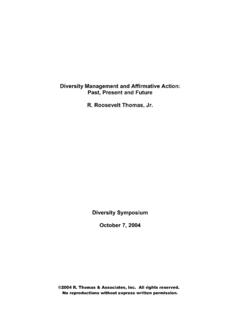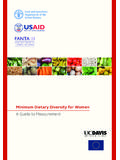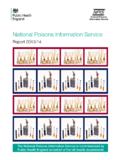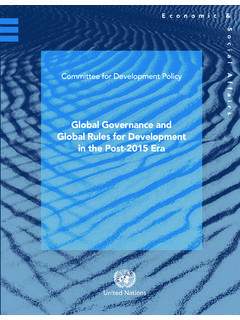Transcription of Standards for Organizations Around the World
1 95 Expert Panelists Julie O Mara Alan Richter, for Organizations Around the Worldsponsored by10th Anniversary Edition 2016 FREE TO USE PERMISSION REQUIREDF irst and Primary Sponsor. The diversity Collegium. See page more on the GDIB. Go to Global D&I Benchmarks at to download the free GDIB, user tools, and other information; to donate to help support D&I research; and to learn more about The diversity Collegium. Accessibility and Alternate Format. The GDIB authors are striving to make the GDIB and user tools accessible. Generally we are following the guidelines provided by the W3C Web Accessibility Initiative (WAI), a worldwide initiative to make the Web more accessible for persons with disabilities, which is a critically important D&I goal.
2 As this 2016 GDIB goes to press, and while we have designed this edition of GDIB with accessibility in mind, we still have some work to do. For that reason and for further accommodation we are also providing an Alternate Format of the GDIB logo. The logo is a stylized version of the new GDIB Model. It is set in a circle to convey the ongoing and never-ending importance of diversity and inclusion. The equilateral triangle in the center symbolizes equality and solidarity or strength and represents the Bridging Group. Colors have a wide range of meaning across cultures. What may be interpreted as a positive meaning for one color in one culture may be a nearly opposite meaning in another culture. We have been thoughtful in our selection of colors and offer our interpretation, which is a combination of a various cultural symbolism.
3 The color yellow was selected for Bridging because it stands for optimism and imagination. The green color for the Foundation Group symbolizes nature and renewal, blue for the Internal Group represents harmony and order, and red for the External Group stands for passion and strength. All are in a vibrant hue, which symbolizes the vitality to succeed. The swirls of dark blue represent the power, energy, and motion needed to sustain this work. And the openness of the swirls showing the colors overlapping one another symbolizes the integration and comprehensiveness needed for D&I to English. We have used culturally neutral English principles to write in clear, translatable language that does not include culturally specific words and phrases (such as idioms or other local expressions).
4 We use American English Improvement and Future Versions. Your feedback, suggestions, and stories of using GDIB are Agreement. The GDIB is shared at no cost for all to use. However, you must request permission. Additionally, all written communications whether a presentation, formal report, or an email sends a message about the GDIB. As part of the Permission Agreement, and to help ensure messaging consistency in delivering high-quality communications, you must follow the GDIB Style Guide. Go to Global D&I Benchmarks at to sign and submit the Permission Agreement and to download the GDIB Style Design. Shawndra Diaz of Out Of Proportion Studios OF CONTENTSINTRODUCTION .. 1 DEFINITIONSD iversity, Inclusion, Global.
5 1 ULTIMATE GOALS OF D&I .. 2 diversity COLLEGIUM SPONSORSHIP .. 4 APPROACHES .. 5 Competence .. 6 Compliance .. 6 Dignity .. 6 organization Development .. 7 Social Justice .. 7 CONNECTING D&I AND SUSTAINABILITY .. 8 THE GDIB MODEL .. 12 DOING COMPREHENSIVE WORK .. 14 THE FIVE LEVELS .. 16 SCOPE OF THE GDIB .. 18 THE FOUNDATION GROUP .. 22 Category 1: D&I Vision, Strategy, and Business Case .. 24 Category 2: Leadership and Accountability .. 26 Category 3: D&I Structure and Implementation .. 28 THE INTERNAL GROUP .. 30 Category 4: Recruitment, Retention, Development, and Advancement .. 32 Category 5: Benefits, Work-life Integration, and Flexibility .. 34 Category 6: Job Design, Classification, and Compensation.
6 36 Category 7: D&I Learning and Education .. 38 THE BRIDGING GROUP .. 40 Category 8: Assessment, Measurement, and Research .. 42 Category 9: D&I Communications .. 44 Category 10: Connecting D&I and Sustainability .. 46 THE EXTERNAL GROUP .. 48 Category 11: Community, Government Relations, and Social Responsibility .. 50 Category 12: Products and Services Development .. 52 Category 13: Marketing and Customer Service .. 54 Category 14: Supplier diversity .. 56 RESEARCH PROCESS .. 58 THE EXPERT PANELISTS .. 62 HOW TO USE THE GDIB .. 66 TERMINOLOGY .. 71 ACKNOWLEDGEMENTS .. 73 OUR ENCOURAGEMENT .. 74 THE AUTHORS .. 75 THE GDIB: AT-A-GLANCE AND BY-THE-NUMBERSFor all sectors, sizes, & types of Organizations Around the world3 DEFINITIONSD iversityInclusionGlobal2 ULTIMATE D&I GOALSA Better WorldBetter Organizations5 APPROACHESC ompetence, Compliance,Dignity, organization DevelopmentSocial Justice4 GROUPSFOUNDATIOND rive the StrategyINTERNALA ttract & Retain PeopleBRIDGINGA lign & ConnectEXTERNALL isten to & Serve Society14 CATEGORIES AND CONCRETE ACTIONS1.
7 Vision2. Leadership3. Structure4. Recruitment & Development5. Benefits6. Compensation7. Learning8. Assessments9. Communications10. Sustainability11. Social Responsibility12. Products & Services13. Marketing14. Supplier Diversity266 TOTAL BENCHMARKS AT 5 LEVELSBest Practices Progressive Proactive Reactive InactiveTHE RESEARCH95 EXPERT PANELISTSHOW TO USE THE GDIBTERMINOLOGY & ENCOURAGEMENTINTRODUCTIONWe offer the Global diversity & Inclusion Benchmarks: Standards for Organizations Around the World (GDIB) to support Organizations globally in the development and implementation of diversity and Inclusion (D&I) best practices. The GDIB helps Organizations : Realize the depth, breadth, and integrated scope of D&I practices; Assess the current state of D&I; Determine strategy, and; Measure progress in managing diversity and fostering and Inclusion has emerged as a worldwide practice that is critical to an organization s success.
8 As with other disciplines, such as quality and safety, Standards are needed to establish criteria by which to measure and monitor progress. This Tenth Anniversary edition the fourth GDIB updates the previous editions published in 2006, 2011, and 2014. No doubt in the future there will be ongoing modifications where new best practices are identified and current ones become less significant. DEFINITIONSWe believe it is important to define what we mean by diversity , inclusion, and global. Users may also wish to research the literature to discover other definitions and select what works best for their organization and its refers to the variety of similarities and differences among people, including but not limited to.
9 Gender, gender identity, ethnicity, race, native or indigenous origin, age, generation, sexual orientation, culture, religion, belief system, marital status, parental status, socio-economic difference, appearance, language and accent, disability, mental health, education, geography, nationality, work style, work experience, job role and function, thinking style, and personality of various diversity dimensions may vary by geography or is a dynamic state of operating in which diversity is leveraged to create a fair, healthy, and high-performing organization or community. An inclusive environment ensures equitable access to resources and opportunities for all. It also enables individuals and groups to feel safe, respected, engaged, motivated, and valued, for who they are and for their contributions toward organizational and societal goals.
10 Global simply means that the GDIB is designed to apply to Organizations anywhere in the World . These Benchmarks are not limited to multinational Organizations or those Organizations that work internationally. The Benchmarks are not specific to a country or culture. 2016, 2014, 2011, 2006 by Julie O Mara and Alan Richter. All rights reserved. Go to for permission diversity & Inclusion Benchmarks Standards for Organizations Around the WorldUltimate goals of D&I:Creating a better World Improving organizational performance 2016, 2014, 2011, 2006 by Julie O Mara and Alan Richter. All rights reserved. Go to for permission diversity & Inclusion Benchmarks Standards for Organizations Around the WorldTHE ULTIMATE GOALS OF diversity AND INCLUSIONWhen considering the ultimate goals of diversity and Inclusion (D&I), people tend to emphasize one of two perspectives: helping to make the World a better place for all or helping to improve organizational performance.







